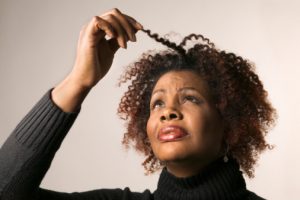 Traction alopecia is a specific type of hair loss that results when tension is applied to hair for a prolonged period of time. In this way, traction alopecia differs from other types of hair loss in that it is behavioral. The progression of traction alopecia may be exacerbated by the affected individual, with areas of thinning or balding becoming more pronounced as hair is pulled, twisted, excessively styled, or otherwise abused over time.
Traction alopecia is a specific type of hair loss that results when tension is applied to hair for a prolonged period of time. In this way, traction alopecia differs from other types of hair loss in that it is behavioral. The progression of traction alopecia may be exacerbated by the affected individual, with areas of thinning or balding becoming more pronounced as hair is pulled, twisted, excessively styled, or otherwise abused over time.
Because traction alopecia is behavioral in nature, there are no prescription medications that can be used to treat it. Instead, preventing this condition from causing significant hair loss requires the individual to make changes in the way he or she styles, treats, and cares for their hair. Additionally, it is vital for both men and women to know the main causes of the condition so they may identify and prevent further hair loss before it becomes noticeable.
Top 5 Causes of Traction Alopecia
In general, any behavior that puts an unnecessary amount of stress or tension on the hair for a prolonged period of time may contribute to traction alopecia. Below are the 5 most common instances in which this can happen:
- Wearing unnecessarily tight ponytails, pigtails, or braids for a long period of time.
- Trichotillomania, a mental disorder characterized by incessant (and often unconscious) hair twisting, plucking, or pulling.
- Hairstyles that require hair to be tightly wound for a prolonged period of time.
- Hairpieces and weaves that must be affixed / clipped to the hair.
- Helmets, particularly compression-helmets like those worn while playing football, snowboarding, skiing, horseback riding, etc.
Getting Proactive: How to Prevent Traction Alopecia
Preventing traction alopecia hinges upon the ability to identify the root cause of the condition. From there, behavioral modification is necessary to ensure further hair loss will not be experienced. In some cases, it can be as simple as making a conscious effort to braid one’s hair more loosely, and to remove the braids at the end of each day to reduce tension buildup.
In other instances, however, behavioral modification can be much more difficult. When the individual unconsciously twists, pulls, or plucks their hair due to stress or anxiety, for example, a more comprehensive approach must be taken. In addition to identifying the condition, the individual must also explore the mental or emotional “triggers” that ultimately drive them to mistreat their hair. Only by disarming those underlying triggers will the individual be able to stop the condition from becoming worse.
Treating Traction Alopecia
Several hair loss treatments have been proven effective in treating traction alopecia. As noted above, however, it is critical that the individual must make an effort to identify and cease the behavior that was causing it in the first place. Otherwise, symptoms may progress and the thinning or balding may spread.
Will a Hair Loss Medication Work? Unfortunately, there are no prescription medications that will reverse the signs of traction alopecia. The condition is behavioral in nature, meaning that lifestyle changes must be made in order to treat it.
Low Level Laser Therapy (LLLT) for Hair. Low Level Laser Therapy for hair is a relatively new treatment for thinning and balding hair that uses safe, FDA-cleared lasers to stimulate blood flow to dormant hair follicles. In doing so, LLLT may improve oxygen and nutrient delivery to the hair follicle, promoting natural growth again. For individuals suffering with traction alopecia, LLLT may be used in conjunction with behavioral modification to reduce the visibility of thinning / balding areas.
FUE Hair Transplant. The most effective way to restore areas that have been significantly damaged is through grafting individual hair follicles to the areas where thinning or balding is most prevalent. Follicular Unit Extraction (FUE) involves transplanting individual follicular units to fill-in affected areas with a precise, natural touch.
Hair Loss Consultation at the Hair Transplant Institute
If you or a loved one suspects you suffer with traction alopecia, rest assured you are not alone. Nearly two thirds of men suffer with hair loss, and an estimated 1 in 4 females experiences hair loss as well. To learn more, schedule a consultation with South Florida’s Top Hair Transplant Surgeons.
Readers are also invited to call our Institute directly at 305.925.0222 to learn more about hair loss, restoration, and transplant procedures that produce beautiful natural-looking results.

